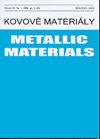Stress corrosion cracking behavior of an as-extruded Mg-1.8Zn-0.5Zr-1.5Gd magnesium alloy in a simulated body fluid
IF 0.7
4区 材料科学
Q4 MATERIALS SCIENCE, MULTIDISCIPLINARY
引用次数: 2
Abstract
The microstructure, corrosion resistance, and stress corrosion cracking behavior of an as-cast and solid-solution Mg-1.8Zn-0.5Zr-1.5Gd biomagnesium alloy after extrusion deformation were studied. Results show that when the extrusion ratio was 7.7 and the extrusion temperatures were 350 and 360 ◦ C, the as-cast and solid-solution alloys underwent complete dynamic recrystallization, and the grains were significantly refined. The precipitated phase in the extruded alloy is mainly composed of a nano-scale (Mg, Zn) 3 Gd and an Mg 2 Zn 11 phase. A small amount of undissolved and broken micron-sized (Mg, Zn) 3 Gd phase particles appeared in the as-cast extruded alloy. The electrochemical corrosion produced during the stress corrosion process peeled off the (Mg, Zn) 3 Gd phase particles and induced rapid dissolution of the adjacent matrix. As a result, stresses were accumulated, and stress corrosion sensitivity occurred. At the same time, some larger-sized cracks appeared in the tensile fracture of the alloy. The difference in grain size and orientation in different regions of the solid-solution extruded alloy leads corrosion fracture to be composed of parallel grooves in different directions. Solution treatment of the magnesium alloy was found to reduce the stress corrosion susceptibility of extruded magnesium alloy and make it promising as a biodegradable implanting material.挤压态Mg-1.8Zn-0.5Zr-1.5Gd镁合金在模拟体液中的应力腐蚀开裂行为
研究了铸态和固溶Mg-1.8Zn-0.5Zr-1.5Gd生物镁合金挤压变形后的显微组织、耐蚀性和应力腐蚀开裂行为。结果表明:当挤压比为7.7,挤压温度为350℃和360℃时,铸态合金和固溶合金动态再结晶完成,晶粒明显细化;挤压合金中的析出相主要由纳米级(Mg, Zn) 3gd和mg2zn 11相组成。铸态挤压合金中出现少量未溶解和破碎的微米级(Mg, Zn) 3gd相颗粒。应力腐蚀过程中产生的电化学腐蚀使(Mg, Zn) 3gd相颗粒脱落,并引起邻近基体的快速溶解。结果导致应力积累,产生应力腐蚀敏感性。同时,合金的拉伸断口出现了一些较大尺寸的裂纹。固溶挤压合金不同区域晶粒尺寸和取向的差异导致腐蚀断口由不同方向的平行凹槽组成。对镁合金进行固溶处理可以降低挤压镁合金的应力腐蚀敏感性,使其成为一种生物可降解的植入材料。
本文章由计算机程序翻译,如有差异,请以英文原文为准。
求助全文
约1分钟内获得全文
求助全文
来源期刊

Kovove Materialy-Metallic Materials
MATERIALS SCIENCE, MULTIDISCIPLINARY-METALLURGY & METALLURGICAL ENGINEERING
CiteScore
1.20
自引率
14.30%
发文量
36
审稿时长
3 months
期刊介绍:
Kovove Materialy - Metallic Materials is dedicated to publishing original theoretical and experimental papers concerned with structural, nanostructured, and functional metallic and selected non-metallic materials. Emphasis is placed on those aspects of the science of materials that address:
the relationship between the microstructure of materials and their properties, including mechanical, electrical, magnetic and chemical properties;
the relationship between the microstructure of materials and the thermodynamics, kinetics and mechanisms of processes;
the synthesis and processing of materials, with emphasis on microstructural mechanisms and control;
advances in the characterization of the microstructure and properties of materials with experiments and models which help in understanding the properties of materials.
 求助内容:
求助内容: 应助结果提醒方式:
应助结果提醒方式:


